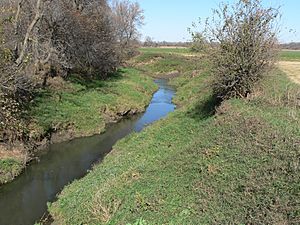Rock Creek (Nebraska) facts for kids
Rock Creek is a small river, about 19.1 miles (30.7 km) long, in Nebraska. It flows into the Elkhorn River. You can find it south of a town called Wisner and it joins the Elkhorn River about one mile west of Beemer.
Long ago, the area where Beemer is now was actually called "Rock Creek." This was before Beemer officially became a village in 1886. The name "Rock Creek" comes from the many rocks found in the riverbed.
The river starts in Stanton County. It begins high up, at about 1,650 feet (503 meters) above sea level. From there, it flows west until it reaches the Elkhorn River in Cuming County. At this point, the elevation is about 1,332 feet (406 meters).
Contents
History of the Rock Creek Community
In the late 1800s, the Rock Creek area was home to many German farmers. These families often felt left out by nearby towns like Wisner and Beemer. This was because they mostly spoke German and worked as farmers or laborers.
To help these German immigrants, two churches were built in the Rock Creek area. These were Zion Lutheran Church and St. John's Lutheran Church. They served the large German Lutheran population living there.
Rock Creek Mill: Grinding Grain for Farmers
One important place in the early Rock Creek community was the Rock Creek Mill. It was also known as Lambrecht's Mill. This mill was built in August 1865 by August Lambrecht. It was a special mill because it could both saw wood and grind grain. It used the power of the water from the creek to run its machinery.
The mill was located about two miles northwest of where the Elkhorn River bridge is today. To make the mill work, Lambrecht built a dam out of earth and brush. This dam helped channel the water to power the mill. Farmers would bring their grain from far away, sometimes even 200 miles, to have it ground into flour. Later, in 1891, Mr. Henry Lambrecht moved the flour mill to Beemer.
Rock Creek Railroad Station: A Busy Stop
When the Fremont, Elkhorn and Missouri Valley Railroad built its tracks from West Point to Wisner in 1871, they created a stop near Rock Creek. This stop was important for trains to get water. It also had a telegraph station, which used the call letters "R C."
In 1886, the railroad company changed the station's name to Beemer. Even though the station's name changed, many people living in the farmlands southwest of Beemer and south of Wisner still called their area "Rock Creek." They never officially formed their own village.
Rock Creek Community Today: Lasting Reminders
Today, there are only a couple of physical reminders left of the original Rock Creek community. One is a old cemetery located southwest of Beemer. It is simply known as "Rock Creek Cemetery."
The other reminder is the first Rock Creek post office. This building is now part of a farmhouse near the St. John's cemetery. These two places help us remember the history of the Rock Creek area.



